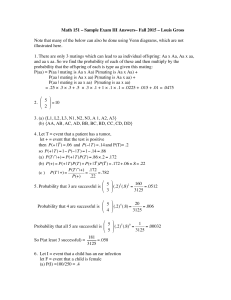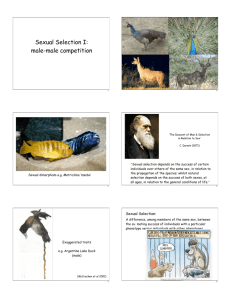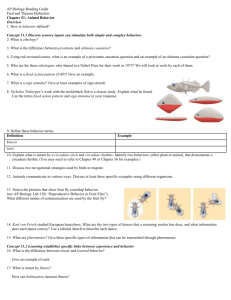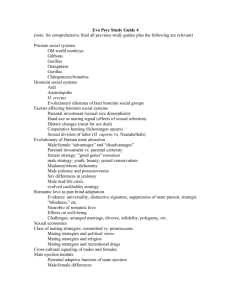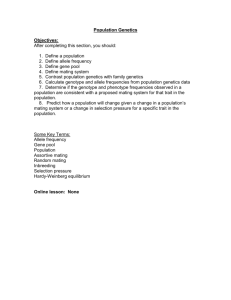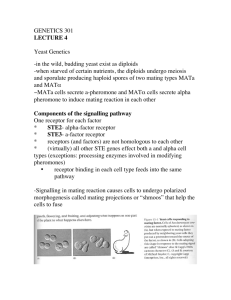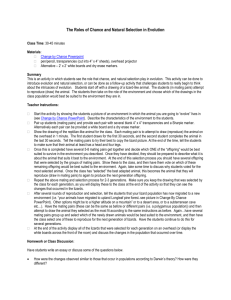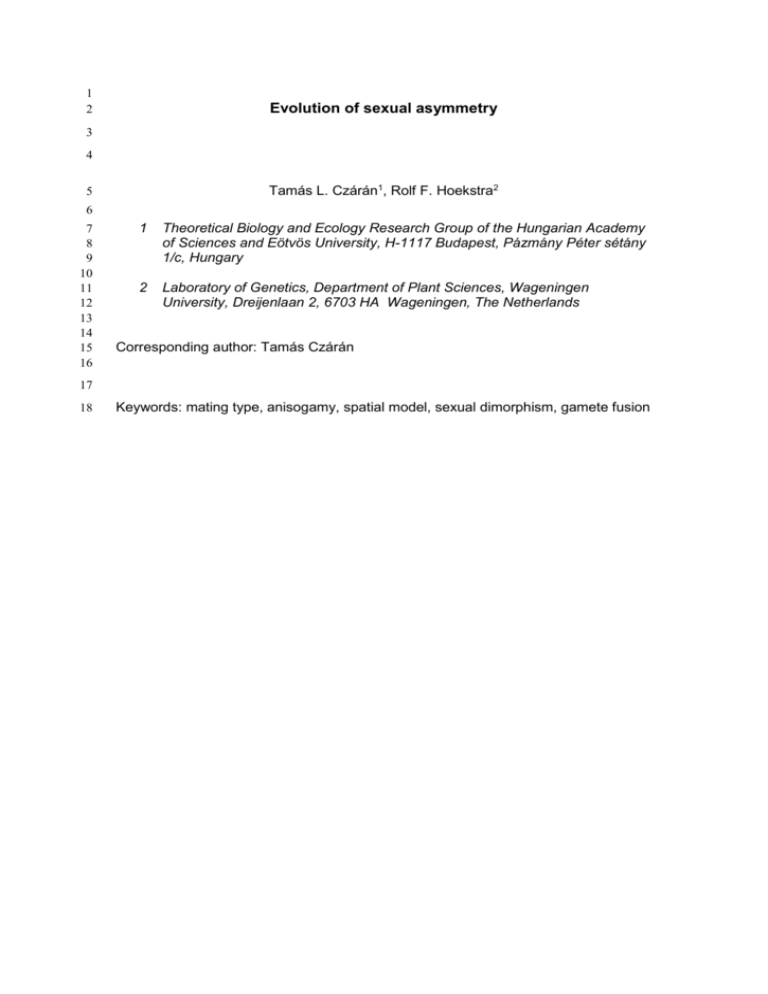
1
2
Evolution of sexual asymmetry
3
4
Tamás L. Czárán1, Rolf F. Hoekstra2
5
6
7
8
9
10
11
12
13
14
15
16
1
Theoretical Biology and Ecology Research Group of the Hungarian Academy
of Sciences and Eötvös University, H-1117 Budapest, Pázmány Péter sétány
1/c, Hungary
2
Laboratory of Genetics, Department of Plant Sciences, Wageningen
University, Dreijenlaan 2, 6703 HA Wageningen, The Netherlands
Corresponding author: Tamás Czárán
17
18
Keywords: mating type, anisogamy, spatial model, sexual dimorphism, gamete fusion
19
ABSTRACT
20
This paper explores the role of spatial population structure in the evolution of
21
mating types using a cellular automaton model. A largely clonal spatial distribution of
22
gamete types, which is plausible in aquatic systems for physical reasons, appears to
23
facilitate the evolution of a binary mating type system. Under broad conditions the
24
model predicts selective removal from the population of supposedly primitive
25
gametes that are able to mate with their own type. Thus a theoretical difficulty
26
inherent to earlier models based on random gamete encounters has been removed.
27
28
29
INTRODUCTION
It seems a general biological rule that sex involves the fusion of gametes
30
(sometimes of other specialised structures) of different type. In most taxa this sexual
31
asymmetry is reflected in the male / female distinction between mating partners
32
and/or between mating sex cells. This paper aims to help understand why sex is
33
asymmetric.
34
The primary difference between male and female is anisogamy, the differential size
35
and mobility of gametes. Anisogamy is thought to have evolved from a more primitive
36
condition of isogamy (for reviews see (Hoekstra 1987); (Randerson and Hurst 2001)
37
see also (Bulmer and Parker 2002)).
38
In isogamous species without apparent male-female differentiation like unicellular
39
green algae (e.g. Chlamydomonas) and fungi (e.g. yeast), the asymmetry in sexual
40
fusion and subsequent development are regulated by a binary mating type system.
41
Mating is only possible between cells of different mating type. Molecular analysis has
42
revealed a remarkable and complex genetic mating type structure (Ferris et al. 2002;
43
Herskowitz 1988). The two mating types in a species consist of so-called idiomorphs
44
(Glass et al. 1990), non-homologous complexes of closely linked genes that occupy
45
homologous positions at the same chromosomal locus. They behave as alleles in
46
being mutually exclusive in meiotic segregation. A similar binary mating type system
47
exists in many filamentous ascomycetous fungi (Coppin et al. 1997), which however
48
often also exhibit male / female differentiation. Only matings between individuals of
49
different mating type are allowed. Thus in mycelia that can function both as male and
50
as female self-mating is prevented. Mating in such species is heterothallic, that is,
51
always between different individuals. However, many ascomycetes are homothallic,
52
i.e. can complete the sexual cycle in a single individual. Homothallic species may
53
lack mating types, such as Aspergillus nidulans, or may consist of individuals that are
54
heterokaryotic for mating type (carry nuclei of both mating types) such as Podospora
55
anserina. In the latter case sexual fusion is between different mating types at the
56
nuclear level, but can occur within a single individual mycelium.
57
In basidiomycetous fungi, morphological sexual differentiation is absent, but mating is
58
regulated by complex mating systems, generating in some cases large numbers of
59
different mating types. Also here, the mating type genes control sexual fusion and
60
post-fusion development (Casselton 2002). Again, mating cannot occur between
61
individuals of the same mating type.
62
In other taxa still other genetic systems exist that control sexual fusion, sometimes in
63
addition to the male-female difference. In monoecious higher plants often self-
64
incompatibility systems occur that effectively exclude self-mating (Nasrallah 2002;
65
Silva and Goring 2001). Among ciliates, several variations on the theme of mating
66
type differentiation exist, which are not further detailed here.
67
68
All these different mating systems have one characteristic in common: mating is
69
always asymmetric. When gender differences exist, mating involves the fusion of a
70
male and a female cell; this may occur when the male and female functions are in
71
different individuals, or when a single individual possesses both male and female
72
functions. When gender differentiation is absent, mating type systems guarantee that
73
sexual fusions are between different types. However, the absence of both gender
74
and mating type differentiation has never been observed. This would imply symmetric
75
sexual fusion: a species in which every sex cell could potentially fuse with any other
76
sex cell. Because gender differences starting with anisogamy most likely evolved
77
from pre-existing isogamy, we should consider the evolution of mating types in an
78
isogamous species to understand why sex is asymmetric.
79
80
Functional explanations of the evolution of a binary mating type system have been
81
explored in theoretical models by (Hoekstra 1982), (Hurst and Hamilton 1992),
82
(Hutson and Law 1993) and (Hurst 1995). These models differ in their biological
83
assumptions. According to (Hurst and Hamilton 1992) and (Hutson and Law 1993),
84
mating types have evolved to suppress harmful conflicts between cytoplasmic
85
elements, while (Hoekstra 1982) suggests that mating type loci have evolved in
86
response to polymorphisms for genes involved in gamete recognition. It is still not
87
possible to conclusively decide between the alternative biological scenario’s
88
(Charlesworth 1994). However, all models envisage as a starting point an initially
89
undifferentiated population in which every gamete can mate with any other gamete,
90
and derive conditions for the evolution of two mating types that exclusively mate with
91
each other and have lost the ability to mate with their own type. A general conclusion
92
emerging from the models is that mating types may invade the initially
93
undifferentiated population under fairly broad conditions, but that the removal of the
94
undifferentiated type requires very strong selective forces. It is this latter aspect
95
which in our view still forms a problem, because it is difficult to see why the original
96
type should be so disadvantageous compared to the differentiated mating types. The
97
mentioned models assume a homogeneous population in which random encounters
98
lead to mating. However, this assumption is likely to be very unrealistic if vegetative
99
reproduction is much more frequent than sexual reproduction, like it is in present-day
100
protists, and if the mobility of the cells is low. Since the motion of cells or gametes in
101
water is characterized by a Reynolds number (the ratio of the inertial forces to the
102
viscous forces) smaller than one (Purcell 1977) clonally related cells will tend to
103
remain in each others vicinity, and therefore a clonal distribution of cells and gametes
104
is expected, rather than a well-mixed homogeneous population. This implies that
105
mating types will have a smaller chance of finding a suitable mating partner than in a
106
homogeneous population, since they are unable to mate within their clone, while the
107
undifferentiated gamete type has no reduced opportunity for mating, although most
108
matings will be intra-clonal. As shown in a theoretical study by (Iwasa and Sasaki
109
1987) the “mating kinetics” may strongly influence the optimality of a sexual system.
110
In order to investigate the effects of spatial population structure on the evolution of
111
mating types, we have analysed this process in a cellular automaton model, which
112
allows precise consideration of the kinetics of gamete encounters.
113
114
115
116
The Mating Type Competition System
The basic setup of our model is similar to that of (Hoekstra 1982). The model
117
organism is an aquatic unicellular ‘alga’ with a haplontic life cycle. Three different
118
types of haploid cells compete for space and reproduce both vegetatively and
119
sexually. During the periods between instances of sexual reproduction, the cells
120
multiply vegetatively, producing genetically identical daughter cells. When entering
121
the sexual cycle, a vegetative cell turns into a gamete that can fuse with another
122
gamete. In their gamete stage the three types of cells differ in their mating capacities
123
as represented by different configurations of recognition molecules on the cell
124
surface, as shown below.
125
126
127
G1
G2
G3
128
129
130
131
The first gamete type G1 is ‘pan-sexual’ and can mate with any potential partner
132
including its own type, while the other two, G2 and G3, are mating types, unable to
133
mate with their own kind. Thus the system allows four kinds of matings: G1.G1, G1.G2,
134
G1.G3 and G2.G3 of which only the last one involves both mating types.
135
In this basic model we furthermore specify the following assumptions. The
136
fitness of a vegetatively produced daughter cell is equal to (or lower than, see below)
137
that of its parent. Sexual fusion produces a dormant zygote which upon germination
138
gives rise to haploid vegetative cells through meiotic division, in which the parental
139
gamete types segregate as if determined by a mendelian pair of alleles. To these
140
meiotic products – “post-zygote” vegetative cells –a higher fitness, i.e., a higher
141
division rate and/or a lower death rate, is attributed than to “pre-zygote” vegetative
142
cells not having gone through a sexual cycle in the near past. That is, we assume
143
that sexual offspring have an immediate short-term fitness advantage over asexually
144
derived daughter cells. The actual advantage may be dependent on whether the
145
zygote has been produced by outbreeding (with at least one of the gametes involved
146
belonging to one of the two mating types) or inbreeding (both gametes pan-sexual).
147
In general we may, but need not, assume that inbred zygotes yield vegetative cells of
148
somewhat less (but still positive) fitness advantage than outbred zygotes. Note that
149
here “outbreeding” and “inbreeding” mean mating between different and identical
150
gamete types, respectively, i.e., we assume – without specifying the precise nature of
151
this outbreeding advantage -- that mating between different gamete types may result
152
in on average fitter offspring than mating between cells of the same (pan-sexual)
153
gamete type. The fitness advantage of sexually derived vegetative cells fades away
154
in time during successive rounds of vegetative reproduction (fitness erosion due to
155
the accumulation of harmful mutations), but it can be re-gained through another
156
sexual event. This means that post-zygote cells return to the pre-zygote state when
157
they are not involved in a new sexual cycle for a sufficiently long time.
158
As for the ecology of the system, we assume that the habitat consists of a
159
limited amount of sites that cells can occupy, and that the three cell types are
160
competing for these sites. Death events leave empty sites behind, which can be
161
occupied later by new offspring. The chance of a newborn cell to settle is proportional
162
to its division rate and the number of empty sites available. In accordance with what
163
has been said earlier about the fitness advantages of sex, three different division
164
rates and death rates are possible: one for pre-zygote, the second for inbred post-
165
zygote, and the third for outbred post-zygote vegetative cells. The straightforward
166
fitness order of these three types is: Wpre-zygote < Wpost-zygote,inbred Wpost-zygote,outbred.
167
The fusion of two gametes produces a zygote of double size compared to a
168
gamete, and the zygote enters a dormant state with zero rates of division and death.
169
Zygotes leave dormancy at a constant rate, giving rise to post-zygote vegetative cells
170
which inherit the mating type of the gametes they are produced by, and gain fitness
171
according to whether the mating was of the inbreeding or the outbreeding type.
172
Fig.1 is a diagram of the possible state transitions in the mating type system.
173
The number of possible states for a site is 12 (including the empty state), according
174
to the type of the cell occupying the site. Thus a site can be in any one of the 3 types
175
of pre-zygote vegetative, 4 types of different zygote, 4 types of post-zygote
176
vegetative, and the empty state.
177
178
179
Figure 1 about here
180
The Nonspatial Model
Based on Fig.1, the mathematical formulation of the nonspatial (mean-field)
181
model for the competitive mating type system is straightforward; the differential
182
equations for the 12 site-states are:
183
x r E d x y p Y P Q x X
y r E d y x p X P Q y Y
p r E d p x y 2 p X Y P Q p P Q
Z xy 2 xy Xy xY XY 2 g Z xy
Z xp 2 xp Xp xP XP xQ XQ 2 g Z xp
Z yp 2 yp Yp yP YP yQ YQ 2 g Z yp
Z pp 2 p 2 pP P 2 pQ PQ Q 2 2 g Z pp
X R E D X y p Y P Q X X g Z xy Z xp
Y R E D Y x p X P Q Y Y g Z xy Z yp
P R E D P x y p X Y 2 P Q P P g Z xp Z yp
Q R E D Q x y p X Y P 2Q Q Q 2 g Z pp
184
E d x y p D X Y P D Q E r x y p R X Y P R Q
185
186
where x, y and p are the numbers of sites occupied by pre-zygote vegetative cells (x
187
and y: mating types, p: pan-sexual type), Zxy, Zxp, Zyp are the sites of outbred, and Zpp
188
are those of inbred zygotes. Similarly, X, Y and P are sites of outbred, Q are those of
189
inbred post-zygote vegetative cells. E is the number of empty sites within the habitat.
190
The parameters of the model are listed and described in Table 1.
191
192
Table 1 about here
193
194
The right-hand side of the differential equations for the sites occupied by pre-
195
zygote vegetative cells (x, y and p) has three terms. The first defines the vegetative
196
fitness of the corresponding cell type (divisions and deaths under the competitive
197
effect of all cell types present in the habitat), the second is the outflow from the pre-
198
zygote vegetative state due to sex, and the third is the inflow due to the fitness
199
erosion of post-zygote vegetative cells. Zygotes have no vegetative fitness; the first
200
term in their differential equations is the inflow due to sex, the second is the outflow
201
due to germination. Post-zygote vegetative cells have a vegetative fitness different
202
from that of pre-zygotes (first term); they form zygotes fusing (after induction to
203
sexual competence) with both pre- and post-zygote cells matching in mating type
204
(second term); their fitness advantage erodes at a constant rate resulting in an
205
outflow into the pre-zygote state (third term), and the germination of dormant zygotes
206
maintains an inflow from the zygote states (fourth term). The number of empty sites
207
is increased by the deaths of vegetative cells (first three terms) and decreased by the
208
number of sites taken by newborn vegetative offspring (fourth term). The total
209
number of sites does not change in time, so the 12 time derivatives sum up to zero.
210
211
The Spatial Simulation Model
With assumptions as similar to the nonspatial system as possible, we have
212
213
implemented a site-based (cf. (Czárán 1998)), spatially explicit stochastic cellular
214
automaton model to which the nonspatial system above is a mean-field
215
approximation. The arena of the spatial model is a set of sites arranged in a 300x300
216
square grid of toroidal topology to avoid edge effects. Each site can be occupied by
217
any one of the 11 cell types (3 pre-zygote, 4 post-zygote vegetative types and 4
218
types of zygote) or it can be empty. Zygotes occupy two adjacent sites.
The pattern is updated one randomly chosen site at a time, i.e., we use an
219
220
asynchronous random updating algorithm. Any site chosen for update can be empty,
221
occupied by a vegetative cell, or occupied by a zygote. We specify the algorithm for
222
each of these cases in turn. A schematic diagram of a single step of updating is given
223
in Fig.2.
224
225
Figure 2 about here
226
Empty site update
After updating, an empty site can be occupied by one (and only one) of the
227
228
vegetatively produced offspring of the cells in the 8 neighbouring sites (i.e., the
229
Moore neighbourhood of the focal site), or it remains empty. Each vegetative
230
neighbour i has a chance pi to put a daughter cell into the empty site. pi depends on
231
the vegetative reproduction parameter I (0 I 1) of neighbour i. I is the spatial
232
analogon of ri in the mean-field model, and it takes one of three possible values
233
depending on whether i is in the pre-zygote, the inbred or the outbred post-zygote
234
state.
235
Specifically, the chance of the empty site to remain empty is
8
236
p e 1 i ,
i 1
237
so the probability that the offspring of neighbour i takes the site is
238
pi
i
1 pe
.
239
The rationale behind this formalism is that each neighbour attempts putting an
240
offspring into the empty site with a probability i, but only one of the candidate
241
offspring survives. The chance of survival is proportional to the reproduction
242
parameter of the mother cell.
243
244
245
Vegetative site update
Updating a site occupied by a vegetative cell may result in four possible
246
outcomes: turn the site into the empty state (death), leave it as it was (survival
247
maintaining fitness), change the vegetative status of the resident cell from post-
248
zygote to pre-zygote (survival with fitness erosion), or produce a zygote (sex). The
249
probability of a death event depends on the death probability of the cell occupying
250
the site, which in turn depends on its vegetative status (pre-zygote, inbred or outbred
251
post-zygote). With a mating partner around, a surviving vegetative cell may enter the
252
sexual cycle with probability s turning itself and a randomly chosen, suitable
253
neighbour into gametes, and mate. The result is a dormant zygote occupying the two
254
neighbouring sites of the fused gametes. A survivor skipping sex may keep its
255
original fitness, or – if it was a post-zygote cell – it can lose its fitness advantage with
256
a probability f (which is the spatial analogon of the fitness erosion rate in the
257
mean-field model).
258
259
260
Zygote site update
A zygote can do two things: remain dormant (with probability 1 – ) or
261
germinate (with probability ). A germinated zygote yields two vegetative cells, the
262
mating types of which are the same as those of the gametes which produced the
263
zygote. The vegetative status of the cells thus obtained is post-zygote, and they can
264
be either inbred or outbred, depending on the parental gamete type combination. The
265
daughter cells are positioned at random into the two sites the zygote had occupied.
266
267
268
269
RESULTS
The specific questions we address with both the mean-field model and the
cellular automaton are the following:
270
271
272
273
274
275
a) Are there reasonable parameter values that allow the coexistence of the mating
types and the pan-sexual type?
b) Under what (if any) circumstances is it possible that the mating types exclude the
pan-sexual type?
c) Does spatial structure play an important role in the outcome of the mating type
competition system?
276
277
Coexistence of the two Mating Types and the Pan-Sexual Type
278
Numerical solutions to the mean-field model and simulations with the cellular
279
automaton reveal that the system admits a single stable equilibrium state both in the
280
non-spatial and in the spatial setting (Fig.3). The actual equilibrium densities depend
281
on the parameters, i.e., on the vegetative growth rates r, R, R’, the vegetative death
282
rates d, D, D’, the germination rate g, the sex rate and the finess erosion rate in
283
the mean-field, and the corresponding probability parameters in the cellular
284
automaton model. Having explored a broad range of the parameter space - with
285
straightforward constraints on the fitness parameters (birth and death rates), i.e., with
286
D D d r R R - we found that it is the strength of the inbreeding effect
287
(the difference of D and D’ and that of R’ and R) and the rate of fitness erosion that
288
has the most interesting effects on coexistence. Changing the remaining parameters
289
– the sex rate and the germination rate – within reasonable limits ( > 0, g > 0) does
290
not affect the results in a qualitative sense.
291
Figure 3 about here
292
293
We have scaled the inbreeding effect into a single parameter , defined by
the equations
294
295
D D D D
R R R R
,
296
297
where = 0 represents no inbreeding effect (i.e., the vegetative cells germinated
298
from outbred zygotes have the same fitness as those produced by inbred zygotes),
299
and > 0 means a fitness difference in favour of outbred offspring.
Fig. 4 shows the equilibrium densities of the mating types and the pan-sexual
300
301
type, the zygotes and the empty cells across a range of the - projection of the
302
parameter space, for both the mean-field model (Fig.4a) and the cellular automaton
303
(Fig.4b). It is obvious from the graphs that the sum of mating types, pan-sexual and
304
zygote equilibrium densities (and thus the equilibrium density of empty sites) is
305
almost unaffected by the parameters, but the relative frequencies of the mating types
306
and the pan-sexual type vary. This applies to both the mean-field and the spatial
307
model.
308
Figure 4 about here
309
Role of space
310
Fig.4a and Fig.4b, which show the results of the two models might look quite
311
alike at first sight, suggesting that spatial constraints like short-range interactions and
312
limited dispersion might not play a decisive role in the dynamics of the gamete type
313
competition system. Upon closer inspection of the data, however, this impression
314
turns out to be completely wrong. Even though the general shapes of the 3D graphs
315
are similar for the non-spatial and the spatial model, there are important differences
316
between them as well.
317
One of these differences shows up in the biologically significant case of very
318
small and values. In the mean-field model, at = 0, that is, at no fitness
319
advantage for outbreeding, the pan-sexual strain excludes the mating types for any
320
positive rate of fitness erosion ( > 0). At = 0 (no fitness loss during vegetative
321
multiplications), on the other hand, it is the mating types who win for any > 0. At
322
= 0 = , the mating types and the pan-sexual type coexist, and the same applies to
323
any parameter combination satisfying 0 . Thus we can say that the non-
324
spatial (mean-field) model allows coexistence for almost any parameter combination,
325
except for the biologically less feasible (and of 0 measure) margins of the parameter
326
plane. It predicts in general that both the mating types and the pan-sexual type
327
should have persisted, even if at variable relative frequencies. The cellular
328
automaton model yields a different prediction, admitting the exclusion of the pan-
329
sexual type, i.e., the victory of the two mating types on a considerable section of the
330
parameter plane, including the = 0 = point and its close neighbourhood (Fig.3).
331
332
333
Alternative adaptations?
In the spatial model the ultimate exclusion of the pan-sexual strain – wherever
334
it happens – is a result of its producing too many dormant zygotes. The conclusion
335
seems to be that the pan-sexual cells are too frequently induced to become sexually
336
competent and that the resulting high mating frequency impairs their ecological
337
competitiveness. A logical next question to ask is then: can the pan-sexual strain
338
prevent its elimination by lowering its sensitivity to the induction of sexual
339
competence? With modified versions of both the mean-field model and the cellular
340
automaton we have simulated the effect of such an “adaptation” (Fig.5). The only
341
modification made to the original models was the reduction by 40 percent of the
342
chance that a pan-sexual cell gets induced by a neighbouring gamete resulting in
343
mating. As it is obvious from a comparison of Figs. 4 and 5, this does not solve the
344
problem of the pan-sexual strain – to the contrary, the chances of the mating types to
345
displace the pan-sexual are even slightly better in the modified models for the largest
346
part of the parameter space. In the mean-field model the relative frequency of the
347
pan-sexual population at equilibrium is smaller almost everywhere except for small
348
nonzero values of the inbreeding effect (compare Figs. 4a and 5a). In the cellular
349
automaton the pan-sexual strain does a little better for very high values of both the
350
inbreeding effect and the fitness erosion rate, but suffers more everywhere else
351
compared to the original model without sex rate reduction (compare Figs. 4b and 5b).
352
Figure 5 about here
353
354
DISCUSSION
355
356
There are a few conclusions that apply to any simulation regardless of its
357
being non-spatial or spatial. Not surprisingly, increasing , the fitness advantage of
358
outbreeding favours the mating types, because all their sexual interactions produce
359
outbred offspring, while always part of the matings of pan-sexual gametes produces
360
inbred offspring with a smaller fitness. Less obviously, increasing the fitness erosion
361
rate benefits the pan-sexual type in general, because its effective sex rate is
362
higher: every mating attempt of a pan-sexual gamete can be successful, unlike for
363
the mating types which refuse inbreeding. Therefore the pan-sexual type has more
364
chance than the mating types to reset its eroded fitness to the post-zygote level
365
through mating. The faster the fitness erosion, the more pronounced the advantage
366
of being pan-sexual, hence the more frequent the pan-sexual strain becomes.
367
In the mean-field model the coexistence of mating types and the pan-sexual
368
type at = 0 = is a spatially unrobust phenomenon. It is highly dependent on the
369
assumption that the system is well-mixed, i.e., each cell encounters other cells of
370
each type with a probability exactly proportional to the relative frequency of that
371
particular type within the whole habitat. It is the breaking of this interaction symmetry
372
in the cellular automaton that gives the mating types a definite advantage compared
373
to the pan-sexuals, even at = 0 = (see Fig.4). The detailed mechanism is as
374
follows: At = 0 it makes no difference whether the mating is inbred or outbred, and
375
at = 0 the fitness advantage once obtained in a single event of sex cannot be lost.
376
Since dormant zygotes do not die, empty sites can only be produced by the death of
377
vegetative cells, but the death rates are all equal and independent of gamete type,
378
because (after a short transient period) every vegetative cell is in the post-zygote
379
state. For the same reason the birth rates are also equal for all the vegetative cells,
380
so the only factor that can make a difference between the cell types is the availability
381
of empty sites: the limiting “resource” for reproduction. In the mean-field model the
382
empty sites are equally available to any cell, so the growth rates of the pan-sexual
383
and the mating type strains are identical in the long run, hence their coexistence. In
384
the cellular automaton, however, each strain develops patches. The mating type
385
strains do not have sex at all within their own patch, only at the interface with the
386
patches of other strains. The pan-sexual strain has sex all the time everywhere in the
387
habitat, therefore a larger part of its population is in the dormant zygote state. It is for
388
this reason that at the interface with the mating type patches the pan-sexual strain
389
has a smaller supply of vegetative invaders and thus a smaller chance to capture an
390
empty site there. This results in a travelling front between a mating type patch and a
391
pan-sexual patch and ultimately in the demise of the pan-sexual population
392
altogether. This effect can even overcompensate a small disadvantage for the mating
393
types arising from increasing the rate of fitness erosion slightly above 0, therefore
394
the close neighbourhood of the = 0 = point on the parameter plane belongs to
395
the mating types as well. We think that it is exactly this mechanism that makes the
396
mating types victorious in the spatial model at many parameter combinations that
397
allowed for coexistence in the mean-field approximation. The elementary events at
398
the interfaces between patches of different gamete types have a profound effect on
399
the ultimate outcome of their competition.
400
An alternative explanation for the difference of mean-field and cellular
401
automaton results could be that it is the finite size effect that kills off the pan-sexual
402
population from the spatial model at many parameter combinations. Indeed, the
403
cellular automaton is a finite system, the margins of the state space of which are
404
sinks, but looking at the striking difference of the behaviours of the frequency
405
trajectories at = 0 = for example (or anywhere else where the mating types take
406
over) in the two models proves that it is not stochastic drift but a real dynamical trend
407
that eliminates the pan-sexual strain in the cellular automaton (see Fig.3). The
408
equilibrium value for the pan-sexual type is so far from zero in the mean-field model
409
and its decrease to zero so steady in the cellular automaton that drift as the cause of
410
the difference can be safely ruled out. Moreover, if the pan-sexual strain could be
411
drifted to extinction, so could the mating types, but in fact we have never obtained
412
ambiguous outcomes: sufficiently long replicate simulations always yield the same
413
result. This applies to the whole range of the parameter space.
414
In order to explain the net effect of sex rate reduction on the fitness, and thus
415
on the survival chances of the pan-sexual population one has to consider two
416
different aspects. On the one hand, sex rate reduction decreases the relative fitness
417
of the pan-sexual strain, because it decreases the frequency of both its inbred and
418
outbred matings, the means of keeping fitness high. This negative fitness effect is
419
most pronounced at high rates of fitness erosion . On the other hand, less frequent
420
sex yields fewer zygotes, i.e., fewer dormant cells with 0 growth rate (recall that
421
zygotes do not multiply and do not die). If the populations are viable, i.e., if they have
422
a vegetative growth rate higher than 0, then less frequent mating (dormancy) is
423
beneficial in terms of the average fitness of the pan-sexual population. This effect
424
dominates at low values of , where the fitness advantage of sex does not vanish
425
too fast. A comparison of Fig. 4 and 5 shows that neither these effects are strong, but
426
both are detectable. The net influence on the mean-field model is quantitative, the
427
size of the parameter domain of coexistence is not much affected. In the cellular
428
automaton model the overall effect of sex rate reduction is a slightly larger domain of
429
coexistence: the pan-sexual strain cannot exclude the mating types at high fitness
430
erosion rates, and it is somewhat more persistent at medium values of . In all, it is
431
quite obvious that sex rate reduction is not an efficient strategy for the pan-sexual
432
strain to avoid exclusion by the mating types.
433
434
435
There is a logical possibility that asymmetric cell fusion has evolved for other
reasons than and prior to sex and has subsequently been incorporated in the
436
evolution of a full sexual cycle (the sequence of syngamy, karyogamy and meiosis).
437
In that case sex would have been asymmetric from the start. This speculative idea
438
has been analysed theoretically by (Hoekstra 1990) (see also (Bell 1993)). The
439
present analysis clearly does not apply to that scenario, but implicitely explains why
440
sexual asymmetry did not disappear once evolved.
441
442
443
444
445
446
447
448
449
450
451
452
453
454
455
456
457
458
459
460
461
462
463
464
465
466
467
468
469
470
471
472
473
474
475
476
477
478
479
480
481
482
483
484
485
Bell, G. 1993. The sexual nature of the eukaryote genome. J Hered 84:351-9.
Bulmer, M. G., and G. A. Parker. 2002. The evolution of anisogamy: a game-theoretic approach. Proc
R Soc Lond B Biol Sci 269:2381-8.
Casselton, L. A. 2002. Mate recognition in fungi. Heredity 88:142-7.
Charlesworth, B. 1994. Evolutionary genetics. The nature and origin of mating types. Curr Biol 4:73941.
Coppin, E., R. Debuchy, S. Arnaise, and M. Picard. 1997. Mating types and sexual development in
filamentous ascomycetes. Microbiol Mol Biol Rev 61:411-28.
Czárán, T. 1998. Spatiotemporal models of population and community dynamics. Chapman & Hall,
London.
Ferris, P. J., E. V. Armbrust, and U. W. Goodenough. 2002. Genetic structure of the mating-type locus
of Chlamydomonas reinhardtii. Genetics 160:181-200.
Glass, N. L., J. Grotelueschen, and R. L. Metzenberg. 1990. Neurospora crassa A mating-type region.
Proc Natl Acad Sci U S A 87:4912-6.
Herskowitz, I. 1988. Life cycle of the budding yeast Saccharomyces cerevisiae. Microbiol Rev 52:53653.
Hoekstra, R. F. 1982. On the asymmetry of sex: evolution of mating types in isogamous populations.
Journal of theoretical biology 98:427-451.
Hoekstra, R. F. 1987. The evolution of sexes. Pp. 59-91 in S. C. Stearns, ed. The evolution of sex and
its consequences. Birkhaeuser Verlag, Basel.
Hoekstra, R. F. 1990. The evolution of male-female dimorphism: older than sex? Journal of Genetics
69:11-15.
Hurst, L. D. 1995. Selfish genetic elements and their role in evolution: the evolution of sex and some of
what that entails. Philos Trans R Soc Lond B Biol Sci 349:321-32.
Hurst, L. D., and W. D. Hamilton. 1992. Cytoplasmic fusion and the nature of sexes. Proceedings of
the royal society of london series b biological sciences 247:189-194.
Hutson, V., and R. Law. 1993. Four steps to two sexes. Proc R Soc Lond B Biol Sci 253:43-51.
Iwasa, Y., and A. Sasaki. 1987. Evolution of the number of sexes. Evolution 41:49-65.
Nasrallah, J. B. 2002. Recognition and rejection of self in plant reproduction. Science 296:305-8.
Purcell, E. M. 1977. Life at low Reynolds number. American Journal of Physics 45:3-11.
Randerson, J., and L. Hurst. 2001. The uncertain evolution of the sexes. Trends in Ecology and
Evolution 16:571-579.
Silva, N. F., and D. R. Goring. 2001. Mechanisms of self-incompatibility in flowering plants. Cell Mol
Life Sci 58:1988-2007.
Acknowledgements
Support from grant no. T 037726 from the Hungarian Scientific Research
Fund (OTKA) and a Visiting Scientist Grant from Wageningen University to
Tamás Czárán are gratefully acknowledged.
Figure Captions
486
487
488
Figure 1
489
Box diagram of the mean-field model. Box arrows: death of vegetative cells; loop arrows:
490
clonal division; full arrows: sexual fusion; dot-headed arrows: germination; dashed arrows:
491
fitness erosion
492
493
Figure 2
494
Flow chart of a single site update of the CA algorithm
495
496
Figure 3
497
Mating type, pan-sexual and zygote abundances in time, at zero fitness erosion rate ( = 0))
498
and zero inbreeding effect ( = 0). Other parameters (in all simulations):
499
Mean-field: birth rate of pre-zygote cells: 0.001; birth rate of post-zygote cells: 0.0015; death
500
rate of pre-zygote cells: 0.12; death rate of post-zygote cells: 0.08; sex rate: 0.0003;
501
germination rate: 15.0; grid size: 90.000
502
CA: birth probability of pre-zygote cells: 0.8; birth probability of post-zygote cells: 0.9; death
503
probability of pre-zygote cells: 0.3; death probability of post-zygote cells: 0.2; sex probability:
504
0.8; germination probability: 0.8; grid size: 300x300 (= 90.000)
505
506
Figure 4
507
Simulation results:
508
509
510
511
512
A) mean-field (fitness eroision rate range: 0.0 – 20.0; inbreeding effect range: 0.0 – 1.0;
abundance range: 0 – 90.000 )
B) CA (fitness erosion probability range: 0.0 – 1.0; inbreeding effect range: 0.0 – 1.0;
abundance range: 0 – 90.000 )
513
Figure 5
514
Simulation results with 40% sex rate (sex probability) reduction in the pan-sexual strain.
515
Scales as in Fig. 4.
516
A) mean-field
517
B) CA



